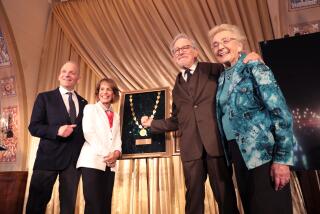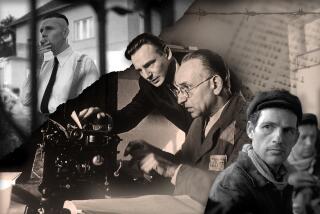Shoah Foundation completes preservation of Holocaust testimonies
- Share via
It’s a wrap for the Shoah Foundation Institute’s ambitious, 18-year project to gather and preserve testimonies from more than 52,000 Holocaust survivors and witnesses.
The foundation, established in 1994 by Steven Spielberg following his making of the movie “Schindler’s List,” announced Monday that the last interview -- with Hungarian survivor Feher Istvan -- was digitized June 20 and will soon be available to view online, alongside 105,000 hours of oral history from the Jewish Holocaust.
Taken from 1994 to 2000, the testimonies span 32 languages and 56 countries. While most of the interviews were of Jewish survivors, the foundation also solicited interviews with witnesses and other victims of the Holocaust, including homosexuals, Jehovah’s Witnesses and others who fell prey to the Eugenics programs under Nazi Germany.
In 2006, when the foundation became part of the USC Dornsife College of Letters, Arts & Sciences, attention shifted to how best to preserve those testimonies so that future generations could remember.
The clock was ticking. Just as interviewers had to race against time to reach aging survivors before they passed away, preservationists at the foundation also faced a critical deadline. The tapes on which the interviews were taken would begin to deteriorate after 20 years. That meant interviews recorded in 1994 would slowly start to disintegrate in 2014.
The curse of technology is that the newer the medium, the shorter its life span, explained Sam Gustman, the foundation’s chief technology officer. Traditional film deteriorates after five decades, while video tape can be counted on to last 20 years. Computer hard drives begin to fail after five years and DVDs start succumbing to “bit rot” after just two years.
With contributions from technology companies Oracle and Nirvanix, the foundation came up with a system for regularly moving the video files to whatever the newest media happens to be. The files are also backed up for safe keeping on computer servers outside USC.
“We’ll be saving the files to newer media as they come out,” Gustman said.
Why not just use film and be done for 50 more years? For one thing, it’s expensive. Making film copies of 235,000 videotapes would have cost $140 million, compared with the tens of millions of dollars required to digitize and maintain the video files over the same time period, Gustman said.
Secondly, digitizing the testimonies lets the foundation more easily share the archive online with the general public and with more than 40 universities around the world. It also lets engineers like Gustman build systems for searching the videos in ways that aren’t possible with film.
Each minute of testimony, for example, is indexed by what is mentioned in that minute. Researchers interested in how victims survived, for example, could search the terms “food” and “hiding,” and zero in on the specific place in every interview where those words were mentioned. Families could also search for names phonetically, since many survivors changed the spelling of their names when they emigrated to other countries following the war. Historians can focus on specific geographies because the interviews are also indexed by locations mentioned.
The system is so advanced that the foundation has developed several technology patents around its video search capabilities, Gustman said.
For a geekier dive into the project, including a peek at USC’s voracious “tape robots,” check out the video on the group’s website.
RELATED:
Scrambling to preserve Holocaust memories
Holocaust still grips the academy
A vivid renewal for L.A.’s first Holocaust museum
More to Read
From the Oscars to the Emmys.
Get the Envelope newsletter for exclusive awards season coverage, behind-the-scenes stories from the Envelope podcast and columnist Glenn Whipp’s must-read analysis.
You may occasionally receive promotional content from the Los Angeles Times.










